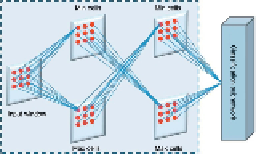Image Processing Reference
In-Depth Information
If
c
i
,
j
1
and
c
i
,
j
2
satisfy a specific constraint, the region under consideration is seen as
RC
(
R
egion to be
C
ategorize) and the values are retained as elementary features of such a region.
Otherwise, the region is divided in four sub-regions each of dimension equal to
w
/2. The pre-
processing subnetwork is applied again to the newly defined regions. The fuzzy intersections
computed by the preprocessing subnetwork are fed to a clustering subnetwork which is fed
scribed in the following.
3.2 Clustering Subnetwork
each corresponding neuron at the previous layer. In particular, at each iteration, a learning
step is applied to the clustering subnetwork according to the minimization of a
Fuzzines Index
FIGURE 4
The preprocessing networks.
The output of a node
j
is then obtained as:
where and , where
w
j
,
i
q
indicates the connection weight
between the
j
ith node of the output layer and the
i
ith node of the previous layer in the
q
ith cell-
plane,
q
= 1, 2. Each sum is intended over all nodes
i
in the neighborhood of the
j
th node at
the upper hidden layer.
f
(the
membership function
) can be sigmoidal, hyperbolic, Gaussian, Ga-
borian, etc. with the accordance that if
o
j
takes the value 0.5, a small quantity (usually 0.001)
is added; this reflects into dropping out instability conditions.
g
is a similarity function, e.g.
correlation, Minkowsky distance, etc. To retain the value of each output node
o
j
in [0, 1], we
apply the following mapping to each input image pixel
g
:





Search WWH ::

Custom Search